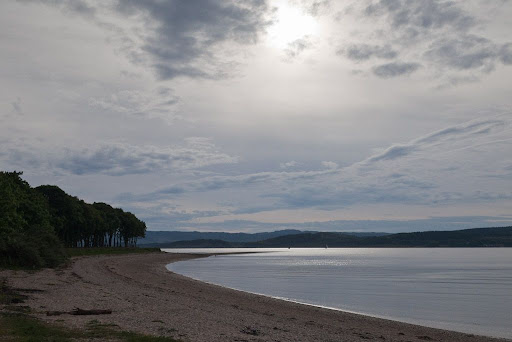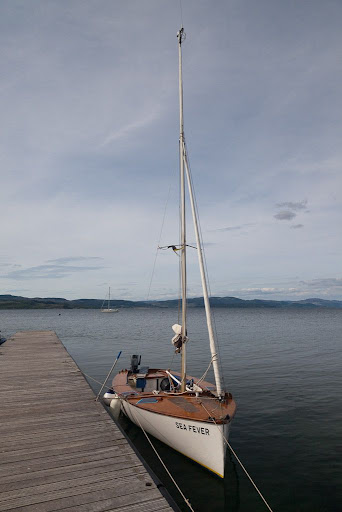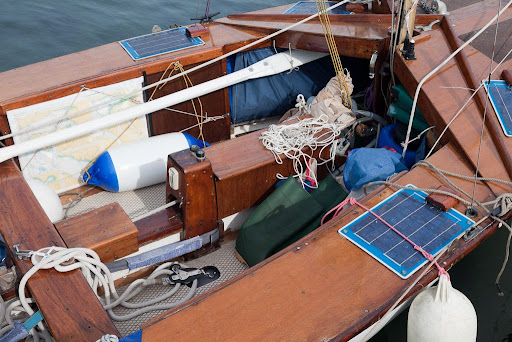We set off across the Hunterston Channel for the Little Cumbrae. To our right a huge 225m bulk carrier, Grace Future, had just pulled away from the Hunterston ore terminal. We crossed well in front of it and soon came across the Campbeltown creel boat...
...Silver Spray III, lifting her pots on the far side of the channel.
We paddled past the southern tip of Little Cumbrae, we were bound for Port Leithne which sits under St Blane's Hill on Bute.
To the west of Little Cumbrae we crossed the Firth of Clyde channel and came across another Cambeltown creel boat Five Sisters. The Firth of Clyde used to be full of fish but there are none left. The only thing these boats catch are prawns which have increased in numbers since the fall of the fish populations.
We now caught sight of our landfall on Arran, Sannox, at the mouth of the great glen of the same name.
To the NW of Sannox, the Cock of Arran stretched away towards Kintyre, which is a somewhat less than priapic peninsula.
Looking back across the Firth of Clyde channel, we could still see...
...Five Sisters lifting her pots and Grace Future was by now well down the Hunterston Channel. She was floating high after having offloaded her cargo of ore.
Imagine you are at the edge of the sea on a day when it is difficult to say where the land ends and the sea begins and where the sea ends and the sky begins. Sea kayaking lets you explore these and your own boundaries and broadens your horizons. Sea kayaking is the new mountaineering.
Tuesday, November 09, 2010
Monday, November 08, 2010
There be dragons at the end of rainbows in the Clyde!
We arrived at Ardrossan ferry terminal at dawn. The low sun was just lighting the mountain tops of Arran. We left two cars here and the four of us drove north to Portencross in my car with the sea kayaks on the trailer.
Heavy clouds and rain were blotting out the landscape but just as we were about to be enveloped in wet greyness, a rainbow appeared.
The new type 45 frigate HMS Dragon appeared out of the end of the rainbow. She had arrived off Arran on her first day of sea trials.
Our destination was the Isle of Arran, but it was rapidly being blotted from sight.
It was a really tricky launch over slippery rocks from the car park at Portencross. I was very grateful for the help Tony and Phil gave me in carrying my kayak and launching it.
We were soon on the water and Jennifer led the way towards Gull Point on the Wee Cumbrae and our first stop at distant Garroch Head on Bute.
Heavy clouds and rain were blotting out the landscape but just as we were about to be enveloped in wet greyness, a rainbow appeared.
The new type 45 frigate HMS Dragon appeared out of the end of the rainbow. She had arrived off Arran on her first day of sea trials.
Our destination was the Isle of Arran, but it was rapidly being blotted from sight.
It was a really tricky launch over slippery rocks from the car park at Portencross. I was very grateful for the help Tony and Phil gave me in carrying my kayak and launching it.
We were soon on the water and Jennifer led the way towards Gull Point on the Wee Cumbrae and our first stop at distant Garroch Head on Bute.
Sunday, November 07, 2010
Ailsa Craig from Lendalfoot, Ayrshire.
A 32km day trip round Ailsa Craig in the outer Firth of Clyde.
Tidal streams between the Ayrshire coast and Ailsa Craig are generally weak, towards the Craig they are about 0.5knots at springs. The NE going flood starts about +0535 HW Greenock (-0530 HW Dover) and the SE going ebb starts about -0050 HW Greenock (+0030 HW Dover).
Remember to take a good broad brimmed hat.
A little rockhopping in the Firth of Clyde.
3,000 sea kayaks behind Ailsa Craig, but all was quiet.
Hats are de rigeur on the far side of Ailsa Craig.
A fog horn and a siren on Ailsa Craig.
Photo album map.
Tidal streams between the Ayrshire coast and Ailsa Craig are generally weak, towards the Craig they are about 0.5knots at springs. The NE going flood starts about +0535 HW Greenock (-0530 HW Dover) and the SE going ebb starts about -0050 HW Greenock (+0030 HW Dover).
Remember to take a good broad brimmed hat.
A little rockhopping in the Firth of Clyde.
3,000 sea kayaks behind Ailsa Craig, but all was quiet.
Hats are de rigeur on the far side of Ailsa Craig.
A fog horn and a siren on Ailsa Craig.
Photo album map.
A fog horn and a siren on Ailsa Craig.
All too soon we had come right round Ailsa Craig to the silent south foghorn. It last bellowed into the mists of the Firth of Clyde in 1966.
Photo Phil Toman.
It was now time to say farewell to this remarkable island and its teeming birds.
Photo Phil Toman.
As we left the island in our wakes, we could not help but be grateful that such a natural wonder is so close to home. The west coast of Scotland has such an incredible variety of coast line that it is truly a World class sea kayaking destination!
The Ayrshire coast gradually got closer but we knew that Ailsa Craig's siren call would soon call us back again.
Photo Phil Toman.
It was now time to say farewell to this remarkable island and its teeming birds.
Photo Phil Toman.
As we left the island in our wakes, we could not help but be grateful that such a natural wonder is so close to home. The west coast of Scotland has such an incredible variety of coast line that it is truly a World class sea kayaking destination!
The Ayrshire coast gradually got closer but we knew that Ailsa Craig's siren call would soon call us back again.
Saturday, November 06, 2010
Hats are de rigeur on the far side of Ailsa Craig.
Even although we have paddled round Ailsa Craig many times, we are always stunned by the teeming gannet colony on the SW cliffs. We could hardly hear ourselves shout over the constant croaking of the gannets. There are about 35,000 pairs nesting on the island in the spring and summer.
Close under the cliffs, the smell of the guano was quite overpowering...
...and our hats were absolutely essential as the sky was full of the largest sea birds in the North Atlantic. A steady, white, and smelly rain was falling!
Close under the cliffs, the smell of the guano was quite overpowering...
...and our hats were absolutely essential as the sky was full of the largest sea birds in the North Atlantic. A steady, white, and smelly rain was falling!
Friday, November 05, 2010
3,000 sea kayaks behind Ailsa Craig, but all was quiet.
Photo Phil Toman
Setting off anticlockwise round Ailsa Craig, we passed a yacht and a motor cruiser.
Photo Phil Toman
I don't know who was more surprised, them, seeing our puny little sea kayaks (with no engines) so far offshore, or us, by the size of their bottle sized wine glasses! Mind you the wine would be the least of their expense. This Fairline Targa 44 comes with a choice of twin 370hp or twin 435hp diesels and would cost about half a million quid, for the basic version. Yikes, that's at least 3,000 sea kayaks!
We approached the north fog horn...
..and were dwarfed beneath its long silent and now rusting trumpet.
The dark mouth of Swine Cave was devoid of pigs and no grunting or squealing echoed from within.
We continued under the dark, sunless and overhanging rocks of the Eagle's Seat...
...until we emerged into the sun and our eyes, ears and noses were about to experience one of Nature's wonders!
Setting off anticlockwise round Ailsa Craig, we passed a yacht and a motor cruiser.
Photo Phil Toman
I don't know who was more surprised, them, seeing our puny little sea kayaks (with no engines) so far offshore, or us, by the size of their bottle sized wine glasses! Mind you the wine would be the least of their expense. This Fairline Targa 44 comes with a choice of twin 370hp or twin 435hp diesels and would cost about half a million quid, for the basic version. Yikes, that's at least 3,000 sea kayaks!
We approached the north fog horn...
..and were dwarfed beneath its long silent and now rusting trumpet.
The dark mouth of Swine Cave was devoid of pigs and no grunting or squealing echoed from within.
We continued under the dark, sunless and overhanging rocks of the Eagle's Seat...
...until we emerged into the sun and our eyes, ears and noses were about to experience one of Nature's wonders!
Thursday, November 04, 2010
A little rockhopping in the Firth of Clyde.

Phil and I convened at Carleton Bay to the south of Lendalfoot on the South Ayrshire coast. The light breeze was onshore so to check the sail, I had to head back into the shore...

...before starting the 15km crossing to the great granite monolith of Ailsa Craig.

Ailsa Craig sits right in the middle of the mouth of the Firth of Clyde and it takes a long time to grow in size.

As we approached the rock, the wind backed to the south allowing me to get the sail up.

We landed (with some difficulty in my case) on the spit of granite boulders that extends from the east of the island. The lighthouse is situated here which means it is not visible from the west of the island.

It is a rough landing and tricky to bring a kayak up the green slimy rocks.

We enjoyed lunch on a stony bank at the top of the beach. At 15km distant, the Ayrshire coast is pretty featureless and it is difficult to identify Lendlfoot. You can just make out a transmitter on the summit of Knockormal hill. The launch spot is directly below it.
Tuesday, November 02, 2010
A Fyne trip on Argyll's Secret Coast!

A 21km day trip from Portavadie to Otter Ferry, Loch Fyne.

Auchalick Bay, Loch Fyne
Tidal streams in Loch Fyne are generally weak. In the Otter Ferry narrows:
+0555 HW Greenock (-0510 HW Dover) north-east going flood begins.
+0015 HW Greenock (+0135 HW Dover) south-west going ebb begins.
In mid channel the rate in each direction is 1 knot. Close to the beacon at the end of the spit, the rate is about 2 knots in each direction.
How sweet is the Clyde?
One way trade and a one way voyage.
Missed the gun but not the boat, in Loch Fyne.
Auchalick Bay, Loch Fyne.
High water in Kilfinan Bay.
Reviresco on the Loch Fyne Riviera.
Let them eat oysters, in Otter Ferry.
Fellow travellers on Loch Fyne.
The Oystercatcher, Otter Ferry, Loch Fyne.
Photo album map.
Monday, November 01, 2010
Sea Kayaking desktop wallpaper calendar, November 2010

November, paddling across the Sound of Bute towards the mountains of Glen Sannox, Arran.
The seakayakphoto.com November desktop wallpaper calendar (in a variety of screen resolutions) is available for download here.
Sunday, October 31, 2010
The Oystercatcher, Otter Ferry, Loch Fyne.

On our return to Otter Ferry with the shuttle car from Portavadie we could not help but notice that the Oystercatcher was open.

We enjoyed some excellent Guinness (half pints, since we would both be driving within the hour) in the cozy surroundings but noticed that everyone else was sitting outside.

We decided to join them for our meal...

...and we enjoyed it thoroughly...

...while watching a hazy sunset over Argyll's secret coast on Loch Fyne.
The Oystercatcher is well worth a visit and is especially conveniently situated by the shore. All in all, an excellent sea kayaking pub!
Saturday, October 30, 2010
Fellow travellers on Loch Fyne.

We pulled the kayaks up onto the grass above the shingle beach at otter ferry. We parked beside this hovercraft. Apparently "It's the most environmentally friendly motorised water sport available!" We did not meet the owner and in a way were glad we had not met on the water. Hovercraft produce an enormous number of decibels and it was such a lovely still evening.

I much preferred the look of this lovely old National 18, number 247, Sea Fever. I first came across National 18s in the early '60s, when I was sailing at Chanonry Sailing Club in the Moray Firth. The National 18s from the Findhorn Yacht Club (as it was then known) used to make the 75km round trip across the Firth to take part in the annual Chanonry Regatta.

Having cruised a Wayfarer from '71 to 2007, it was interesting for me to see the adaptations that had been made...

...to allow her to be used for extended single handed cruising and camping.

I had noticed the smaller than standard rig and the owner, Roger Bamford, told me it was a modified Wayfarer rig.

Phil and I had a great chat with Roger, swapping tales of our respective adventures (and sailing rigs!). It turns out that Roger toured regularly all round Britain. This time he had launched at Largs Marina and was spending 3 weeks exploring the Clyde. He had already been up the Gare Loch and Loch Long and had had a wild crossing to Arran the week before. He was now heading up Loch Fyne to Inveraray but hoped to camp at Loch Gair, on the far side of Loch Fyne, that night.
I casually said that I thought he must have a very understanding employer to have so much time on the water. He just laughed and told me his age and that he had retired years ago. It would be rude to say exactly how old Roger was, but let me just say that Phil and I hope that we are as full of life and adventure, when we are that age!
All too soon, we sadly had to say farewell to Roger and recover our shuttle car from Portavadie.






























